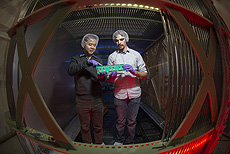MicroBooNE, in 3-D
 |
Tingjun Yang (left) and Wesley Ketchum lead the effort to develop new 3-D reconstruction software for the MicroBooNE experiment. Here they stand inside the MicroBooNE time projection chamber. Photo: Reidar Hahn |
Imagine your job is to analyze the data coming from Fermilab's MicroBooNE experiment.
It wouldn't be an easy task. MicroBooNE has been designed specifically to follow up on the MiniBooNE experiment, which may have seen hints of a fourth type of neutrino, one that does not interact with matter in the same way as the three types we know about. The big clue to the possible existence of these particles is low-energy electrons.
But that experiment could not adequately separate the production of electrons from the production of photons, which would not indicate a new particle. MicroBooNE's detector, an 89-ton active volume liquid-argon time projection chamber, will be able to. To take advantage of this, every neutrino interaction in the chamber will have to be examined to determine if it created an electron or a photon.
And there will be a lot of interactions to study — the MicroBooNE collaboration expects to see activity in their detector once every 20 seconds, including nearly 150 neutrino interactions each day.
If all goes to plan, human operators won't have to worry about any of that. When MicroBooNE switches on next summer, it will sport one of the most sophisticated 3-D reconstruction software programs ever designed for a neutrino experiment.
According to Wesley Ketchum and Tingjun Yang, two postdocs leading the software development team at Fermilab, MicroBooNE's computers will be able to accurately reconstruct neutrino interactions and automatically filter the ones that create electrons. The key to accomplishing this lies in the design of the time projection chamber.
The MicroBooNE detector — the largest time projection chamber in the United States — will be filled with heavy liquid argon and placed in the path of the Booster's neutrino beam. When neutrinos interact with the argon, they create charged particles that ionize the argon atoms. A high-voltage electric field will draw those ionization electrons toward three planes of wires, spaced three millimeters apart. As they pass through, each plane of wires will take a snapshot of the electrons. Taken together, the snapshots will form a full picture of the original particles.
"Three planes of wires at different angles will provide a picture of the neutrino interaction in 3-D," Ketchum said. "We only need two, but the third helps us get rid of ambiguity."
The software should be able to provide clear pictures of the data scientists are interested in studying.
"We're focused on creating an automated reconstruction package that won't require people to go through and give input," Ketchum said. "We hope that we will have the raw data, and the software will give us all the particles produced when a neutrino interacts, with no human needed."
While Ketchum, Yang and the MicroBooNE team work on perfecting the software, they know that even more eyes are on them. The 3-D reconstruction technology used for MicroBooNE will be a smaller version of that used in the Long-Baseline Neutrino Experiment, Fermilab's flagship project. LBNE will use a much larger liquid-argon TPC and will require automated reconstruction.
MicroBooNE's TPC will likely be inserted into the detector this month and driven to the newly built experimental hall early next year. It will begin taking data next summer.
"It will run for at least three years and give us a definite answer to the MiniBooNE anomaly," Yang said.
—Andre Salles
|